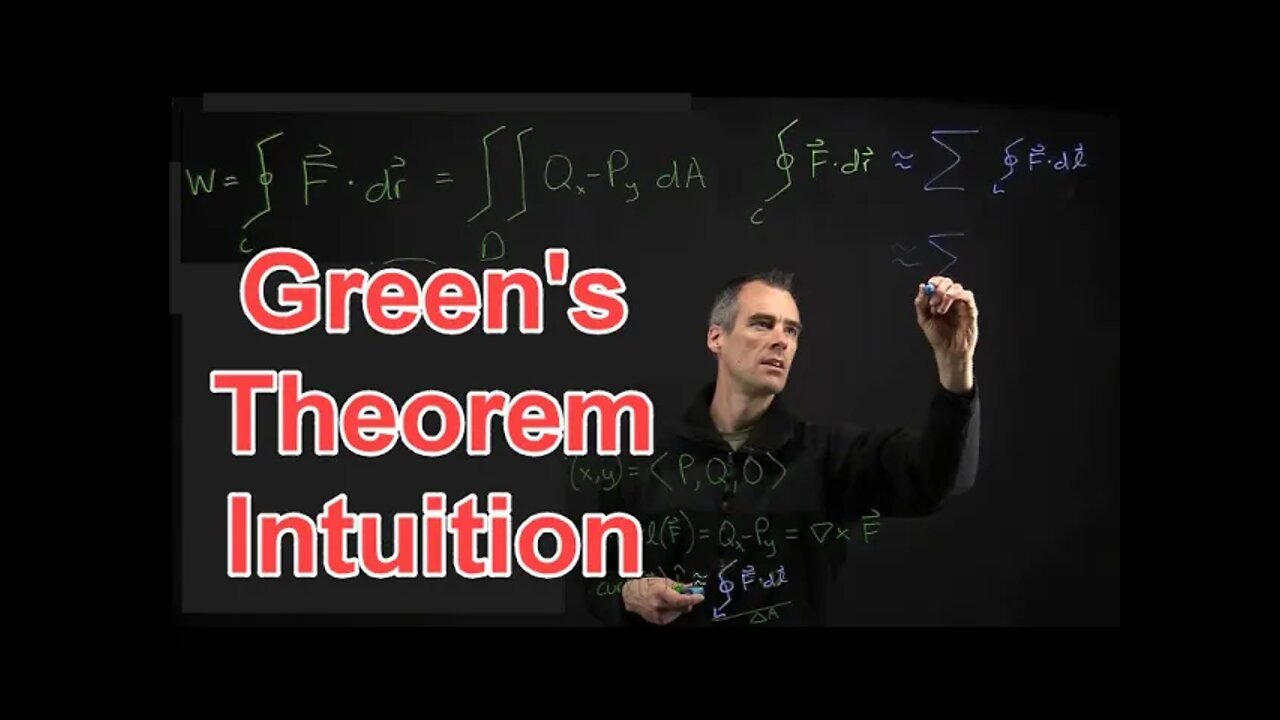Premium Only Content

Green's Theorem Intuition
Perhaps it's immediately obvious to you why a closed line integral over a vector field would equal the double integral of the curl of the vector field over the region D enclosed by the line integral. If so, feel free to move on. But if you're like me, this seems like a rather bizarre equality. So let's take a look at WHY it's true.
Imagine we have a vector field in the xy plane.
Now imagine we have a closed path traversing this vector field.
And imagine we want to find this integral. What would this mean? Well, for example, if the vector field represented the wind velocity at each xy coordinate, the line integral would represent the work done by the wind on an object traveling along this path, in the given direction.
So Green's Theorem tells us this line integral is equal to the double integral of the curl of the vector field, dotted with the k-hat, over the region D enclosed by the path.
OK so here's what's going on.
Imagine instead of finding the work done along that path, we were instead going to cut this up into a bunch of smaller regions, and find the work done along the counterclockwise path surrounding these little regions.
If we added up the work done in all those regions, we'd find that much of it would cancel out. For example, these two regions are next to each other. Say the vector field was heading down here. This would make the work larger for that region on the right, since the vector field would be going along that counterclockwise direction. However, it would make the work on the left region negative, since it would be going against that counterclockwise direction. So if we added these together it would cancel out.
And if we divided this entire D region into these little intervals, you could see everything within the D region would cancel out, but there wouldn't be anything to cancel out what's on the edges, so the work done 'on the edges' would be all that remained.
So we could approximate this line integral is equal to the sum of all the line integrals within the region D
Now here is where it gets interesting. We have been using the definition for curl as del cross F. This is really just a notation for curl though, because while this operation works in cartesian coordinates, it doesn't hold exactly for cylindrical and spherical. The more exact expression for curl is given as the curl (f) dot k-hat \approx line integral around f, divided by the area of the rectangle we are integrating around. So this shouldn’t seem to bizzare, because that line integral is expressing how much that vector is 'curling' around a given point, which is what we know curl represents, that amount of 'spin'. And of course we know our curl is positive in the z direction using the right hand rule, when the rotation is counter-clockwise. Solving this for that line integral, we get this:Now we can plug back this equation in for our line integral and we get this sum.
And everything here will become exact now if we change this sum into an infinite sum, or double integral over this region D. And we are left here with Green's Theorem, which we can adjust a bit if we use our definition for the curl(F) as Q_x - P_y where F is our vector field in the xy plane, F=[P,Q,0].
So that's some intuition behind where we get Green's theorem from
-
 23:23
23:23
MYLUNCHBREAK CHANNEL PAGE
1 day agoAustralia Was Found
63.2K53 -
 1:41:45
1:41:45
The Connect: With Johnny Mitchell
13 hours ago $11.75 earnedMexican Cartels Are Moving MORE Drugs Than Ever, Going To WAR On The Government (Emergency Update)
34.8K4 -
 6:54:01
6:54:01
MissesMaam
9 hours agoFinishin' Red Dead Redemption 💚✨
54.7K7 -
 34:44
34:44
LFA TV
5 days agoMIRACLES DO HAPPEN!
72.1K1 -
 LIVE
LIVE
GamersErr0r
4 hours ago $2.26 earnedMooning My Community
494 watching -
 2:22:59
2:22:59
Banks Atkin Live
7 hours agoChilling playing Games & Vibin
53.4K1 -
 8:08:50
8:08:50
Dragoon_B
8 hours agoNothing crazy - just Counter Strike + Valorant
20.1K1 -
 18:03
18:03
Stephen Gardner
8 hours ago🔥YES!! Trump GETS HUGE win in 4th district court!!
68.6K384 -
 4:40:54
4:40:54
G3T
6 hours ago🔴GET | not saying it
19.1K -
 15:35
15:35
DeVory Darkins
13 hours ago $4.64 earnedGavin Newsom drops CRUSHING BLOW on Democrats
23.7K68